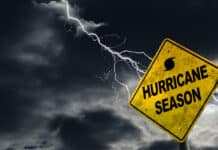
By Heidi Schwartz
Published in the September 2010 issue of Today’s Facility Manager
In the August 2005 issue of Today’s Facility Manager, hurricane expert Bill Begal wrote, “Weather professionals have predicted that the 2005 hurricane season (which began on June 1 and peaks in August through October) will be a record setter as far as damage is concerned. Experts are expecting a total of 12 to 15 tropical storms, seven to nine of which should become hurricanes. Three to five of those hurricanes could become major, with impacts on the East Coast and Gulf of Mexico.” While the East Coast has so far been spared, most people are vividly aware of the truth in this warning.
And yet, when Begal shared this prediction, many didn’t take it seriously. Some may have even thought it was a grossly dramatic overestimation.
Sadly, the overestimate has turned into an understatement. To date, 17 named storms have emerged from the Atlantic basin, and life along the Gulf Coast may have changed forever as a result of back-to-back storms Katrina and Rita.
Katrina’s Scope
After cruising through central Florida as a Category 1 storm, Katrina picked up strength and positioned itself for landfall in the Gulf of Mexico. When the eye of the Category 4 storm passed through the region during the early hours of August 29, few people anticipated the scope of the damage.
In Gulfport, MS, the impact was immediate and significant. Just after the storm passed, Steve Sabac, president of Sun Coast Glass Protection Systems of Boynton Beach, FL, surveyed the area and witnessed its destruction on an unthinkable scale.
“In many respects, it reminded me of the damage inflicted upon Homestead, FL after Hurricane Andrew [a Category 5 storm] in 1992. But what took my breath away was the total storm surge destruction at the Port of Gulfport, where the multi-storied Copa Casino had been moved off its moorings and shoved about a quarter mile inland. Distribution cars housing everything from newsprint to dog food had been destroyed. I could only compare the scene to a bomb explosion,” Sabac says.
Water, Water Everywhere
In New Orleans, LA, the initial impact of the storm was not so well defined. Many people safely evacuated the area, and others innocently took shelter. Some stayed behind and naively hoped for the best.
Throughout the city, conditions were tolerable until power went out early August 29, after which, rapid deterioration occurred in most facilities as they vulnerably sat in the semi-darkness. When the dreaded but predicted levee breaches eventually took place, the situation spiraled out of control.
Randy Springer, assistant administrator of support services for Lindy Boggs Medical Center in New Orleans confirms, “The backups were actually fine with the hurricane. We were fine then. We didn’t have any issues during that time. But when the levees broke, and we had 13′ of water in the street, it filled in the basement of the hospital.”
On-site throughout the storm, Springer acknowledges the numerous redundant systems and precautionary measures in place at the hospital. The key shortcoming in the case of Lindy Boggs was the placement of the backup generators.
“Like many hospitals in New Orleans, they were not up high enough,” he explains. “When we do have rising water like we did during Katrina, we don’t adequately have the necessary backup.”
Without backup power, the facility—like many others in the flooded area—lost its ability to communicate with the outside world. Despite having numerous forms of telecommunications, none would work reliably at this point of the crisis.
So the administrators relied on tried and true methods—incident command center briefings (no fewer than four times a day) followed by a “town crier” system. “Everyone in the hospital had an idea of what was going on, whether it was a need for flashlights or the possibility of food rationing,” Springer says.
Although conditions in the hospital were precarious at best, the facility continued to experience an influx of people attempting to escape the rising flood waters. At its apex, the number of occupants climbed to nearly 700, counting staff, family members, physicians, patients, and evacuees. When helicopters and boats began rescuing people from the facility three days after the storm’s initial hit, the process moved along relatively quickly.
Unsure of the future of the hospital, Springer has been told it will be rebuilt. To prevent the recurrence of Katrina’s miscues, he will suggest a new approach to backup systems for the hospital.
“With an incident of the magnitude of Katrina, we couldn’t have done anything to prevent what happened here,” he says. “What I would like to recommend is that we move all of the electrical generating equipment including the emergency power equipment to the roof of the fourth floor of the hospital. That’s something a lot of the hospitals in the New Orleans area are going to wrestle with.” [Other options are examined in “Planning For Disasters” from Facility Technologist Tom Condon.]
For Bruce Rutherford, managing director for Jones Lang LaSalle’s Houston, TX office, the water damage had additional negative consequences. His company, which manages numerous properties in the affected area, including two high rise properties in downtown New Orleans, has been dealing with the impact of “about a foot and half of water in one building and eight inches of water damage in the other. That might not sound like much, but you must remember that the floodwaters were inundated with the worst kind of pollution,” he says.
With the toxic water gone, black mold damage is the continuing challenge for Rutherford, which means “ripping out the walls up to a height above the mold damage. We’re taking everything out two feet above the highest point of mold damage.” Once all of the water and mold is removed, Rutherford will concentrate on “completely flushing the buildings with fresh air before we turn on the central systems, because we do not want to run the risk of spreading any latent mold elsewhere in the building.”
For Rutherford’s facilities, communication problems were minimized through the use of a remote call center in Chicago. His company, which has facilities all over the world, has experienced everything from Tsunamis in the Pacific to earthquakes in California to floods in Europe.
“We’ve learned that cell phones don’t work when the area is blacked out, so we have alternative telephone means. We’re even equipping some of our buildings with satellite phones for emergency purposes. Communication is king, and you can’t believe how disrupted communications were during Katrina,” Rutherford acknowledges.
Planning For The Worst
Facility and building management professionals who lived through Katrina are still reeling from its catastrophic impact. Many have never witnessed anything like it, and few relish the thought of dealing with an event of this caliber again. Members of the disaster recovery and prevention profession are even surprised by the scope of the devastation.
Like Steve Sabac, disaster recovery expert Bill Begal paid a post-Katrina visit to the areas hardest hit by the storm. He reflects, “I have actively performed work after five hurricanes, so I know how damaging the effects of water, fire, and wind can be.
However, nothing in my past experiences prepared me for the vast and massive damage that I have recently witnessed and continue to witness daily. I can only begin to grasp what it will take to get things back to a state of normalcy.”
Looking ahead, Begal examines the reality of preparing for a storm equal to—or greater than—Katrina, which was “different from any storm I or anyone has seen. Regardless if you were prepared or not, would anything have stopped the flooding and wind damage from a storm of this size and magnitude?”
Most recent estimates for U.S. government spending to repair Hurricane Katrina damage are still being revised. While numbers may reach $100 billion, some businesses will never recover.
“Disaster preparedness planning is the key for any business when it comes to surviving a hurricane. I still believe this is true; however, in certain circumstances, there isn’t much you can do,” Begal admits. “However, preparing for a hurricane should prompt facility managers to secure documents, files, back up files, computer discs, and equipment. If possible, protect these items by removing them from the premises in advance. Computer disks should be backed up regularly or a remote backup service over the Internet can be used that will place data well out of the area of the storm’s influence.”
Facing The Next Storm
Natural disasters are unsympathetic and relentless. Case in point: thousands of Katrina evacuees ended up in Houston, only to be relocated a few weeks later because of the threat posed by Hurricane Rita. Staggering its way towards the Gulf Coast as a Category 5 storm, Rita eventually made landfall on the Louisiana/Texas border as a Category 3 hurricane during the early morning hours of Saturday, September 24, 2005. The storm gave responders an opportunity to demonstrate their revamped, post-Katrina recovery plans, but created less extreme conditions.
Donald Young, vice president of communications at the Houston, TX-based International Facility Management Association (IFMA) says, “We were in a better position than some of the cities hit by Katrina for a few reasons. After being hit with significant flooding caused by Tropical Storm Allison in June 2001, Houston invested a lot of money in its infrastructure, took a hard look at its problems, and came up with something that would help the city handle excessive rainfall. Now there is a series of bayous cut specifically to resolve this problem. There’s also a flood control district that examines how this area drains.” [For TFM’s 2004 Facility Executive Of The Year’s account of the Houston floods, see this link.]
Young adds, “We’re also about 400 or 500 feet above sea level, and we’re at least 50 miles inland (although the city does stretch to the actual bay). Most of the downtown and office parks (with the exception of NASA) lie out of the flood zone.”
Geographical factors and infrastructure improvements contributed to preparations. Additionally, crews were already in place and recovery measures were poised before Rita even made landfall.
Representatives from Disaster Kleenup International (DKI) secured plans and equipment while response teams in the area awaited word from the company’s central command post in Chicago. All told, more than 20,000 pieces of portable equipment, including air movers, dehumidifiers, generators, and portable extraction units were quickly in place.
Although Rita changed course and weakened, it still created the nation’s largest evacuation nightmare and was responsible for numerous deaths due to traffic accidents, tornadoes, and other related tragedies. Despite the punishing winds and rain, Houston, New Orleans, and the oil refining industry were largely spared. Other businesses may not be so fortunate.
“This has clearly been one of the most devastating and costly hurricane seasons in a long time, perhaps ever,” says Dale Sailer, president of Disaster Kleenup International. Even under most extreme conditions, “An appropriate response may enable businesses to begin the process of getting their lives back to normal as fast as humanly possible while minimizing the financial impact of their loss.”
For many organizations, knowing when to respond will be the difference between success and failure. Young says, “Now is a great time to make changes while the event is still fresh in people’s minds.
Despite the predictions, so many things were taken for granted before these storms swept through the Gulf Coast. Consciously ignoring the warning signs of a worst case scenario may be the only action that could add insult to injury in the future.
This article was based interviews with Rutherford, Springer, and Young; additional information was provided by DKI, Begal, and Sabac.



















![[VIDEO] Collect Asset Data at the Speed of Walking a Building](https://facilityexecutive.com/wp-content/uploads/2024/02/maxresdefault-324x160.jpg)